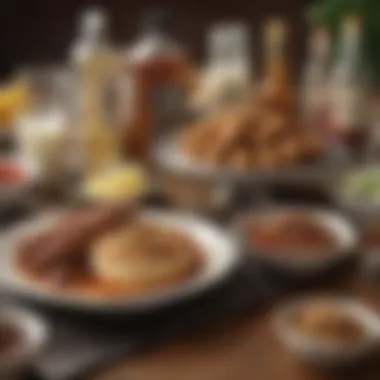Culinary Treasures of the Kentucky Derby


Intro
The Kentucky Derby stands as a pillar of Americana, not merely for its thrilling horse races but also for its eclectic food culture. This annual event draws attention not just from sports enthusiasts, but from food lovers as well, eager to explore the gastronomic offerings that accompany the festivities. As the sound of hooves echoes around the racetrack, the aroma of traditional and contemporary dishes wafts through the air, inviting all to partake in the culinary experience.
Throughout this article, we delve into the rich tapestry of the Derby’s food landscape. From classic southern fare to innovative culinary twists, it is clear that food plays a significant role at this historic event. We will examine the origins of iconic recipes, the impact of locally sourced ingredients, and how these choices reflect both tradition and modernity.
Recipe Overview
Iconic Dishes and Their Heritage
- Bourbon Balls: These small confections, made with Kentucky bourbon, sugar, chocolate, and nuts, embody the spirit of the region. Originally crafted by local confectioners, they provide a sweet treat that is deeply rooted in Kentucky culture.
- Hot Brown: A decadent open-faced sandwich created in a Louisville hotel in the 1920s, featuring turkey, bacon, and a rich Mornay sauce. This dish is both a staple at Derby parties and a symbol of Kentucky hospitality.
Cuisine Type
The predominant cuisine type at the Kentucky Derby can be described as Southern with diverse influences. Traditional southern cooking showcases the use of local ingredients, which encapsulate the essence of the region. Each dish tells a story that reflects a deep connection to the land and its resources.
Ingredients List
Detailed Ingredient Breakdown
Each iconic dish carries its own unique set of ingredients:
- Bourbon Balls: Kentucky bourbon, finely chopped nuts, dark chocolate, powdered sugar, and vanilla.
- Hot Brown: Sliced turkey, crispy bacon, tomatoes, Mornay sauce (made from butter, flour, milk, and cheese), and toasted bread.
Substitutions for Dietary Needs
When preparing these dishes, consider the following substitutions:
- For Bourbon Balls: Use non-alcoholic bourbon alternatives for a kid-friendly version.
- For Hot Brown: Substitute turkey with jackfruit for a vegetarian option, or use gluten-free bread to accommodate gluten sensitivities.
The culinary offerings at the Kentucky Derby not only satiate appetites but also create a sense of community, reflecting shared traditions.
As the Kentucky Derby approaches, it serves as a reminder of how food can unite people, celebrating culture while offering delights for the palate. In the sections that follow, we will dive deeper into specific dishes, their recipes, and the local ingredients that make this gastronomic adventure at the Derby unforgettable.
Prelude to the Kentucky Derby
The Kentucky Derby is more than just a horse race; it is a celebration of culture, tradition, and, importantly, food. This iconic event, held annually in Louisville, Kentucky, attracts thousands of spectators who come to enjoy not only the thrilling race but also the wide array of culinary experiences that accompany it. Understanding the Kentucky Derby's gastronomic aspect provides insights into its historical significance and the cultural values it represents.
In this article, we will explore how the Kentucky Derby has evolved over the years and how food has always been a central component of the festivities. From traditional dishes rooted in regional flavors to modern takes that reflect current culinary trends, the Derby's gastronomic delights are as diverse as its attendees.
Historical Context
The Kentucky Derby traces its roots back to the 19th century, specifically to 1875 when the first race was held. Over the years, the event has grown not just as a sporting challenge but also as a cultural milestone. Spectators at the Derby have always had a penchant for indulgence, making food an integral part of the experience. Traditional Southern dishes often make their appearance, mirroring the recipes passed down through generations.
Notably, dishes like Burgoo and Derby Pie have origins steeped in tradition and community values. These foods are not just meant to serve hunger; they narrate stories of the local culture, making the Derby a feast for both the eyes and the palate.
Cultural Significance
Culinary offerings at the Kentucky Derby serve as a reflection of the region's identity. Food plays a vital role in bringing people together, creating memorable experiences that enhance the festive atmosphere of the event. The celebration is not simply about racing but includes gatherings where friends and families share meals, further solidifying community ties.
Additionally, food at the Derby reflects broader trends in gastronomy. Local chefs and food vendors often showcase their creativity by creating unique dishes that coincide with the race day excitement. This blend of tradition and innovation enhances the Derby's appeal, making it a cultural event where food takes center stage alongside the horses.
"Food at the Derby is not just about flavor; it embodies the spirit of Kentucky’s rich culinary heritage."
As we move through this article, we will delve deeper into the culinary traditions, signature foods, and modern interpretations that define the gastronomic landscape of the Kentucky Derby.
Culinary Traditions at the Derby
Culinary traditions at the Kentucky Derby offer a glimpse into the rich tapestry of flavors and techniques that have been honed over generations. The significance of food at the Derby extends beyond mere sustenance; it reflects the cultural heritage and regional characteristics of Kentucky. Each dish tells a story, connecting attendees to the land, the people, and the event itself.
Classic Dishes and Their Origins


Burgoo
Burgoo is a traditional stew that symbolizes communal dining. Originating from the 18th century, this hearty dish combines various meats, vegetables, and seasoning, often through a slow-cooking process. The main characteristic of burgoo is its adaptability; it can include pork, beef, or even game, depending on what is available. This makes it a popular choice for large gatherings at the Derby. Its role in the context of the event is significant mainly because it fosters a sense of togetherness.
The unique feature of burgoo lies in its ability to cater to large crowds without compromising flavor. One drawback could be its long preparation time, but many consider this an essential process that enhances the taste. The stew’s connection to the Derby highlights the importance of food in fostering relationships and creating shared experiences.
Hot Brown
The Hot Brown is another iconic dish that showcases the region’s culinary flair. It is an open-faced sandwich featuring turkey, bacon, and Mornay sauce, baked until bubbly. Its creation at the Brown Hotel in Louisville during the 1920s adds to its historic value. The key characteristic of the Hot Brown is its richness and comforting quality, serving as the perfect indulgence after an exciting day at the races.
The unique aspect of the Hot Brown is the combination of textures and flavors, which offers a delightful experience for diners. However, its heavy nature could be seen as a disadvantage for those seeking lighter fare. Still, it remains a beloved choice at the Derby, representing a blend of Southern hospitality and innovative cooking.
Derby Pie
Derby Pie, a delectable chocolate and walnut pie, embodies the spirit of the Derby. This dish was first introduced by the Melrose Inn in the 1950s, and its secret recipe remains closely guarded. Its main feature is the delightful combination of rich chocolate and crunchy nuts, which create a dessert that appeals to a wide audience.
What makes Derby Pie stand out is its cultural significance; it is often associated with the winning of the race, making it a symbolic treat at the event. While some may argue its sweetness could be overwhelming, it serves as an essential endnote to the culinary experience of the Derby.
Regional Influences
Southern Cooking
Southern cooking is integral to the food culture at the Kentucky Derby. It reflects a blend of diverse culinary traditions, including African, European, and Native American influences. This fusion adds depth and character to traditional Derby fare. The key characteristic of Southern cooking is its emphasis on comfort and community, often utilizing recipes that have been passed down through generations.
The unique feature of Southern cooking found at the Derby includes staples such as cornbread, collard greens, and fried chicken. This inflates the sense of place and tradition, contributing to the authenticity of the culinary offerings. However, some might find the ingredient lists extensive or intimidating, but this complexity is often what makes Southern cuisine so rewarding to explore.
Local Ingredients
Local ingredients play a pivotal role in shaping the dishes served at the Derby. Kentucky's rich agricultural background ensures access to fresh produce, meats, and dairy. The use of local ingredients is beneficial as it supports local farmers and reduces the carbon footprint associated with food transportation.
One unique feature of local sourcing is that it fosters a connection between diners and the land, promoting sustainability and ethical eating. Yet, reliance on seasonal crops can sometimes limit menu options, presenting a challenge for vendors. Regardless, local ingredients remain a critical component of the Derby's culinary identity, emphasizing freshness and quality in every bite.
The blend of classic dishes and regional influences creates an unforgettable dining experience, contributing significantly to the allure of the Derby.
Signature Foods of the Kentucky Derby
The Kentucky Derby is more than just a horse race; it is a celebration of culture and tradition. Central to this festival is the array of quintessential foods that have become symbols of the event. Signature foods play a vital role in enriching the Derby experience, offering not just nutrition but a taste of history and local pride. These culinary delights reflect the regional flavors of Kentucky, showcasing the diverse ingredients that abound in the area. They draw visitors into the heart of Derby culture, allowing them to partake in an age-old tradition while enjoying the festivities.
Mint Julep
Preparation and Ingredients
The mint julep is often regarded as the official drink of the Kentucky Derby. This cocktail is traditionally made with fresh mint, sugar, bourbon, and crushed ice. The preparation involves muddling the mint and sugar together, releasing the essential oils of the mint before adding bourbon and ice.
This drink's simplicity is one of its most appealing traits, allowing the quality of the bourbon to shine through. The use of fresh mint not only enhances flavor but provides a refreshing aroma that enhances the overall drinking experience. Mint julep becomes a popular choice at the Derby, serving as a symbol of southern hospitality.
The unique feature of a mint julep lies in its ritualistic preparation. The balance of sweetness against the bourbon's richness creates an inviting experience. However, it can be seen as too sweet for some palates, which might be a consideration when serving.
Variations Across Region
While the classic mint julep remains a staple, various regional interpretations exist. In some areas, ingredients such as seasonal berries or even flavored syrups are included to create new takes on the classic recipe. This adaptability is important, as it caters to evolving tastes. Regional differences also showcase local craftsmanship and creativity in bourbon making.
The key characteristic of these variations lies in their use of local products, which adds a personal touch to each drink. They provide an excellent opportunity for vendors and drinkers to explore what each area has to offer. However, it is crucial to stay true to the essence of the julep, or it may lose its identity as a Derby classic.
Derby-Focused Culinary Themes
Comfort Foods
Comfort foods are integral to the Derby, as they evoke feelings of nostalgia and warmth. They often include hearty dishes such as burgoo, a traditional stew made from various meats and vegetables. The communal aspect of sharing such foods enhances the festive atmosphere.
These dishes not only satisfy hunger but also bond people together, reinforcing social connections during the event. Comfort foods resonate with many attendees, serving as a reminder of home and heritage. One drawback is that their richness might not appeal to everyone, especially those seeking lighter fare.


Finger Foods and Snacks
Finger foods and snacks hold their own significance at the Derby. These offerings are designed for convenience, allowing guests to mingle and savor delicious bites without interrupting their social engagement. Items like deviled eggs, mini hot browns, and assorted sliders are popular choices.
The key characteristic of finger foods is their portability. This aspect encourages movement and mingling, which fits perfectly within the Derby environment. They also provide a range of flavors and textures that cater to diverse preferences. However, the downside may include making more frequent trips to grab food, which can distract from enjoying the races and festivities.
"The Kentucky Derby is a prime example of how food showcases regional identity and tradition, reinforcing the bond between the event and its local culture."
Modern Culinary Interpretations
The Kentucky Derby is a longstanding tradition that encompasses rich culinary heritage and changing palates. While classic dishes remain integral, modern culinary interpretations introduce innovative flavors and techniques that enhance the Derby experience. These interpretations reflect changing food trends and the incorporating of diverse influences into traditional fare. They not only appeal to a wide array of tastes but also highlight the creativity and skill of contemporary chefs.
Contemporary Dining Experiences
Contemporary dining experiences at the Kentucky Derby focus on elevating the traditional food scene. Chefs are now creating multi-course meals that incorporate both local ingredients and global inspiration. Events like the Taste of Derby have become platforms for chefs to showcase their talents. High-end restaurants and pop-up eateries set up during the event often present unique twists on classic dishes, ensuring a gastronomic journey through rich flavors and textures.
Common elements in these culinary experiences include:
- Seasonal Ingredients: Chefs emphasize the use of ingredients that reflect the season. This enhances flavor and promotes local agriculture.
- Artistic Presentation: Modern plating techniques engage the senses beyond just taste. Visual appeal plays a crucial role in how a dish is perceived and enjoyed.
- Experiential Pairings: Some dining options include pairings of food with craft bourbons that complement the flavors and elevate the overall dining experience.
Fusion Cuisine Styles
Fusion cuisine has emerged as a noteworthy trend at the Kentucky Derby, blending diverse culinary traditions into creative dishes. This approach allows for the combination of flavors, techniques, and ingredients from various cultures, resulting in a unique gastronomic experience. For example, chefs may create an Asian-inspired burgoo or utilize Latin spices in traditional Southern recipes.
Key aspects of fusion cuisine at the Derby include:
- Cultural Collaborations: Partnerships between chefs of different backgrounds lead to innovative dishes that surprise and delight guests.
- Local Meets Global: By marrying local ingredients with international flavors, chefs pay homage to the Derby's roots while embracing modern culinary movements.
- Interactive Dining: Many vendors offer interactive elements, like build-your-own taco bars or customizable bourbon cocktail stations, inviting guests to tailor their dining experiences.
The Role of Food Vendors and Catering
Food vendors and catering services play a critical role at the Kentucky Derby. Their presence not only enhances the spectator experience but also showcases the diverse culinary landscape of the region. The explosion of food options has transformed the Derby into a significant gastronomic event alongside horse racing. For attendees, food becomes a central theme of the celebration, reflecting local flavors and cultural significance.
The variety provided by food vendors enriches the overall atmosphere. Vendors offer a spectrum of choices, from traditional fare to modern interpretations. This variety caters to differing tastes and dietary preferences, providing an inclusive experience for all attendees. Furthermore, culinary creativity is on display, with many vendors trying to outdo each other with unique dishes or presentations.
Food Trucks and Stands
Food trucks and stands have become synonymous with modern event catering at places like the Kentucky Derby. Their mobility allows them to reach a larger audience, and flexibility in menu offerings fits the diverse palates of the crowd. Many vendors harness seasonal ingredients or local specialties to create memorable dishes.
One can witness a mix of cultures represented in the food available:
- Southern comfort dishes: such as shrimp and grits or fried green tomatoes.
- International flavors: ranging from Korean BBQ tacos to gourmet vegan options.
- Classic Derby options: including Derby Pie and burgoo, showcasing the regional culinary identity.
The ambiance created by food trucks adds to the overall festive feel of the event. Patrons line up, sharing their experiences and sometimes even engaging in conversations about the offerings.
Catering Trends
Catering trends at the Kentucky Derby have evolved significantly over the years. What was once simple buffet-style service has now transformed into a more elaborate gastronomic affair. Modern catering is influenced by several factors:
- Emphasis on quality and presentation: Guests now seek beautifully crafted dishes paired with attention to plating.
- Focus on sustainability: More caterers are prioritizing local sourcing and eco-friendly practices, reflecting growing awareness around food production's impact on the environment.
- Health-conscious options: As diners become more health-aware, caterers are introducing lighter fare and alternatives that align with various dietary needs such as gluten-free, vegetarian, and vegan options.
This shift towards more sustainable and health-conscious choices not only responds to changing consumer preferences but also elevates the overall culinary experience at the Derby.
Pairing Food with Bourbon
Pairing food with bourbon is an essential aspect of the gastronomic experience at the Kentucky Derby. The unique flavors of bourbon complement many traditional dishes served during the event. Understanding how these elements interact can enhance the dining experience, making it more enjoyable.
A correct pairing not only elevates the taste of the ingredients but also brings out the complexities in both the food and the bourbon. Factors like sweetness, spiciness, and smoky notes play a key role in these pairings. Additionally, choosing the right bourbon can create memorable culinary experiences for Derby attendees.
Understanding Bourbon
Bourbon is a type of American whiskey that falls under specific regulations, such as being made from at least 51% corn and aged in new charred oak barrels. This aging process imparts distinct flavors to the spirit, which can include notes of vanilla, caramel, and a touch of smokiness.


Different bourbons have their unique profiles. For example, some may lean more towards sweeter notes, while others may be richer and more robust in flavor. Knowing these characteristics allows for better food pairings and creates a more harmonious dining experience.
The method of production and regional variations also contribute to the diversity of bourbons available. This can affect how bourbon pairs with various food options.
Food and Bourbon Pairing Recommendations
When considering pairings, various traditional and modern dishes can perfectly complement specific bourbons. Here are some recommendations:
- Mint Julep: The refreshing notes can pair well with light appetizers such as cucumber sandwiches or shrimp cocktails.
- Burgoo: This rich and hearty stew matches excellently with bourbon rich in spice like Bulleit Bourbon.
- Hot Brown: The creamy texture of this dish complements the vanilla and caramel notes found in Maker's Mark.
- Barbecue Dishes: For smoked meat platters, high-proof bourbon can stand up to the bold flavors.
- Cheese Boards: A selection of cheeses served with a sweet bourbon can balance well together.
Pairing bourbon with the right food doesn't only celebrate tradition but also enhances the enjoyment of flavors, textures, and aromas. Creating a memorable meal is a vital part of the Kentucky Derby experience.
The key to successful food and bourbon pairing is to find a balance. The flavors should harmonize rather than compete, leading to a delightful dining experience.
Health Considerations in Derby Food
The culinary landscape of the Kentucky Derby extends beyond mere indulgence; it invites a thoughtful examination of health considerations associated with traditional foods. The importance of health awareness cannot be overstated at such a grand event. As attendees enjoy festive meals, being mindful of nutritional intake can enhance their overall experience. Key elements include understanding nutrition, making informed choices, and adapting beloved recipes to align with healthier lifestyles.
Nutritional Analysis of Traditional Dishes
Traditional dishes, such as Burgoo and the Hot Brown, are staples of Kentucky Derby cuisine. Their nutritional profiles reveal a combination of comfort and caution. Here is a brief analysis:
- Burgoo: Generally rich in meats and vegetables, Burgoo can vary significantly in its calorie and fat content. While it provides protein from various meats, the addition of starchy vegetables adds carbohydrates. It is best enjoyed in moderation.
- Hot Brown: This dish, featuring turkey and Mornay sauce on bread, is delicious but calorie-dense. Consuming it in smaller portions or sharing can greatly reduce caloric intake while still allowing enjoyment of its unique flavors.
- Derby Pie: Known for its chocolate and nut filling, Derby Pie is a high-calorie dessert rich in sugars and fats. Alternatives might include using less sugar or substituting with healthier ingredients.
Understanding the nutritional values of these dishes helps individuals maintain a balanced diet even during celebratory events.
Health-Conscious Alternatives
There is increasing demand for health-conscious alternatives at the Kentucky Derby. As public awareness of health issues rises, so has the interest in modifying traditional recipes. Here are some ideas:
- Vegetarian Burgoo: Using legumes instead of meats can create a hearty alternative without compromising on taste, offering fiber and plant-based nutrients.
- Healthier Hot Brown: A lighter version could use whole-grain bread, reduce the amount of sauce, and increase layered vegetables. This not only improves the nutritional profile but also adds additional flavors.
- Lower-Calorie Derby Pie: Options include using almond flour crusts or natural sweeteners like agave syrup, which can cut down calories while maintaining sweetness.
Offering these alternatives ensures that everyone, including those with specific dietary restrictions, can partake in the celebration without sacrificing health for enjoyment.
Sustainability in Derby Food Choices
The conversation around sustainability in food choices at the Kentucky Derby is not merely an afterthought. This topic holds significance as it intersects with environmental awareness, local economies, and traditions. As guests indulge in memorable flavors, they also have the opportunity to consider the broader impact of these culinary practices on the planet.
Sourcing Local Ingredients
One of the defining features of sustainability at the Derby is the emphasis on sourcing local ingredients. This strategy reduces transportation emissions and supports local farmers, which ultimately helps stimulate the regional economy. By selecting ingredients from nearby farms, chefs showcase the unique flavors of Kentucky, enhancing the dining experience. Not only are these ingredients fresher, but they also carry stories and histories tied to the land.
Local markets often highlight seasonal offerings, meaning that Derby menus change year by year, allowing chefs to get creative with their dishes. Common local ingredients might include corn, beans, and various vegetables that reflect the Southern palate. The push for local sourcing encourages chefs and vendors to form relationships with suppliers, leading to a more resilient food network and a commitment to maintaining quality.
Waste Management and Reduction Strategies
Waste management practices during the Kentucky Derby are critical for fostering sustainability. The event attracts thousands, leading to significant food waste. To address this, many vendors and organizers implement strategies that minimize and manage waste efficiently.
Some strategies include:
- Composting Food Scraps: Instead of simply discarding leftover food, many vendors participate in composting efforts. This reduces landfill waste and returns nutrients to the soil.
- Using Biodegradable Packaging: Opting for compostable or recyclable containers can further reduce environmental impact.
- Donating Leftovers: Some vendors collaborate with local charities to distribute uneaten food, ensuring that it feeds those in need rather than going to waste.
- Educating Attendees: Many Derby participants are becoming more aware of sustainability practices. By providing information, the event encourages guests to adopt environmentally responsible behaviors.
"Implementing practical waste management and reduction strategies not only aligns with green initiatives but also enhances the overall experience of the Derby."
Sustainability is vital for the future of food culture at the Kentucky Derby. By committing to local sourcing and effective waste management, the event is moving towards a more responsible gastronomic celebration. This dual focus not only enriches the food experience but also safeguards the environment for generations to come.
Ending
The Future of Food at the Kentucky Derby
As society increasingly focuses on sustainability and health, the future of food at the Kentucky Derby will likely reflect these trends. Producers and vendors are expected to enhance their offerings by adding more local, organic, and health-conscious options. Here, several key elements could shape the upcoming culinary landscape:
- Emphasis on Local Sourcing: Local farms and purveyors could play a pivotal role, ensuring that each dish not only supports the community but also highlights the region's unique flavors.
- Health-Conscious Options: With the growing awareness of health and nutrition, traditional dishes might undergo modifications to create healthier versions. This might mean reducing sugars or incorporating more vegetables in classic recipes.
- Culinary Diversity: The impact of globalization could lead to a mix of international cuisines at the Derby, featuring innovative recipes that reflect a broader cultural spectrum.
- Sustainable Practices: Waste management could see improved strategies. This would involve composting and recycling food waste, along with careful planning in procurement to minimize excess production.
"The Kentucky Derby encapsulates more than thrilling horse races; it is a celebration of food that embodies Southern charm and innovation."
In summary, the future of food at the Kentucky Derby will be multifaceted, balancing tradition with modern values. Each dish served can honor the past while looking ahead to healthier, more sustainable choices.















